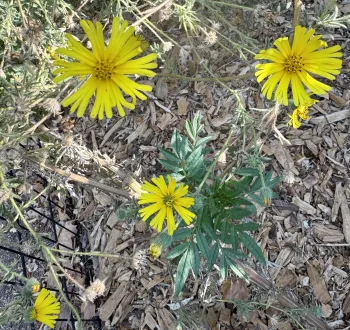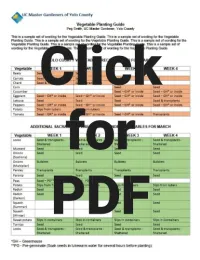
Article and photo by Peg Smith -
As we ease into fall, September is a prime time for planning and planting.
Ornamentals and Annuals
Keep up the deadheading and deep watering, your garden will produce a floral display well into the fall. Don’t be too eager to ‘neaten’ the garden. Many of our beneficial and pollinator friends rely on the dried stems and leaf cover of the fall for protection. Do remove any diseased or injured growth. Start thinking about seed planting for a vibrant spring show. From the middle of the month California poppy seeds can be scattered and gently raked into the top layer of soil. If growing your own seedlings, for each variety, plant seeds into pots at roughly two-week intervals through October. As seedlings mature add them to the garden about every two weeks and the bloom season will be extended. Consider starting some of our wonderful California native annuals such as elegant tarweed Madia elegans, tidy tips Layia platyglossa, yellow lupin Lupinus arboreus and Baby blue eyes Nemophila menziesii
Diseases, Pests, and Beneficials
September temperatures can be hot, so continue providing good water sources for birds and bees. Birds love moving water, if you set up a sprinkler on a hot day you will be able to observe finches, hummingbirds and bushtits cooling off and bathing. Bees prefer shallow water; a simple bee watering station can be made by using a shallow dish with a layer of marbles or stones across the bottom. Fill with fresh water, but be sure to leave some surfaces of the marbles or stones exposed, this allows the bees to settle and drink. Clean and replenish bird and bee watering stations regularly.
Bulbs
September is the best time to consider the bulbs you wish to add to the garden. Bulbs can be pre-ordered through most companies and shipped at the appropriate time for planting in our area.
Fruits
Before the rains come, it’s a good time to prune apricot and cherry trees. Dormant pruning in the winter months is not recommended for cherry and apricot trees, as the moisture-borne fungal diseases that affect these trees will enter through injury or pruning sites. Eutypa, a fungal disease in apricots, causes leaf, branch, and limb dieback and cankers, which can eventually lead to tree death. Clean up any fallen fruit to prevent disease transmission.
Trees and General Pruning
Late summer pruning of trees and shrubs tends to discourage new growth. It is the ideal time to shape, improve air circulation, or reduce the canopy height and spread. If you are aiming to reduce the size of a tree, it is best to remove no more than a third of its height or spread per year until it is at the desired height. It may take a few years of careful reduction pruning, but be patient. The tree will be less shocked than if significant limb pruning is done all in one season.
Fall is an ideal time for new tree selection if you are looking for a particular leaf color. As the days grow shorter and temperatures cool, available nursery trees will show their fall color for your selection.
Soil Improvement
As summer vegetables or annual blooms are pulled, take the opportunity to add compost to each area as it is cleared. A good approach is to always add compost each time an area is cleared or a plant is removed.
Lawns
Fall is the best time to rejuvenate lawns. Late September is ideal. Rake and reseed, cover with a layer of compost. The reseeded areas will develop strong root systems through the winter and spring to cope with the next summer’s heat.

September Vegetable Planting Guide
Click the thumbnail image on the right to open a larger image or the link below to open a PDF of Peg's September Vegetable Planting Guide. This guide will tell you which Yolo County and Sacramento area vegetables are recommended for planting during the month of September, along with how and when to plant them.
